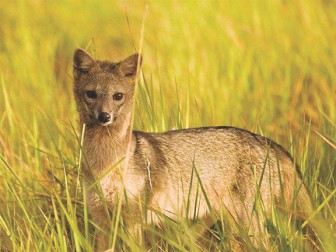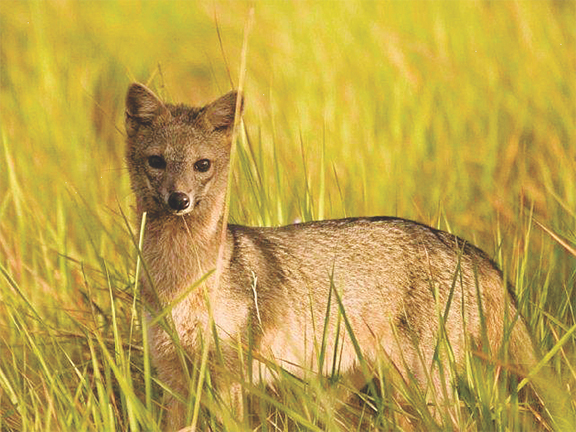The Crab Eating Fox (Cerdocyonthous) or Savannah Fox is the only fox that exists in Guyana. It grows up to 8 kg in weight and is a tawny grey in colour with a moderately bushy tail, black at the tip. These foxes range from the Amazon Basin in Colombia, Venezuela, the Guianas, Brazil, Bolivia, Paraguay, Argentina and Uruguay. They can be found in a range of habitat though their preference appears to be savannah and scrubby areas. They are known to enter rainforest especially if it borders the savannah or open areas.
Foxes are nocturnal and often seen in male and female pairs. In the Rupununi Savannahs they are often seen running in an easy gait as they patrol and hunt their common territory. If caught in the spotlight of an oncoming vehicle while on the road, a fox will keep running in front of the vehicle chasing its shadow. The vehicle would have to stop to allow it to get off the road.
![]() The foxes feed on small vertebrates such as rodents, frogs, birds, fish and reptiles and although they hunt in pairs each captures and eats its food individually. Foxes can be a pest as they will visit settlements and take domestic chickens and eggs.
The foxes feed on small vertebrates such as rodents, frogs, birds, fish and reptiles and although they hunt in pairs each captures and eats its food individually. Foxes can be a pest as they will visit settlements and take domestic chickens and eggs.
Savannah Foxes have monogamous relationships. They breed twice a year with birthing peaking in January or February. There are usually three to six cubs in the litter. At a month old, the cubs can start eating solid food; they are fully weaned by three months. Both the parents feed and guard the cubs. The cubs are sexually mature within a year. The raise of the leg urination usually indicates sexually maturity.
 The Savannah Fox is listed as common and widespread. CITES list the species as Appendix II while IUCN Red List evaluates the population at least concern.
The Savannah Fox is listed as common and widespread. CITES list the species as Appendix II while IUCN Red List evaluates the population at least concern.
Rain forests are rich in biodiversity and are home to many different plants and animals as well as indigenous communities. Humans, even those who don’t live in the rain forest, rely on it for resources such as building materials (wood and lianas), medicine and fruits. Rain forests also provide essential environmental services for life on earth; they create soil as well as prevent soil erosion, produce oxygen though photosynthesis, maintain clean water systems, and are a key defence against climate change.
The Iwokrama Rain Forest is 371,000 hectares, located in the heart of Guyana. Our mission is to develop strategies for conservation and sustainable development for local people in Guyana and the world at large. We are involved in timber, tourism and training. Come and visit us in the rain forest or at http://www.iwokrama.org.









